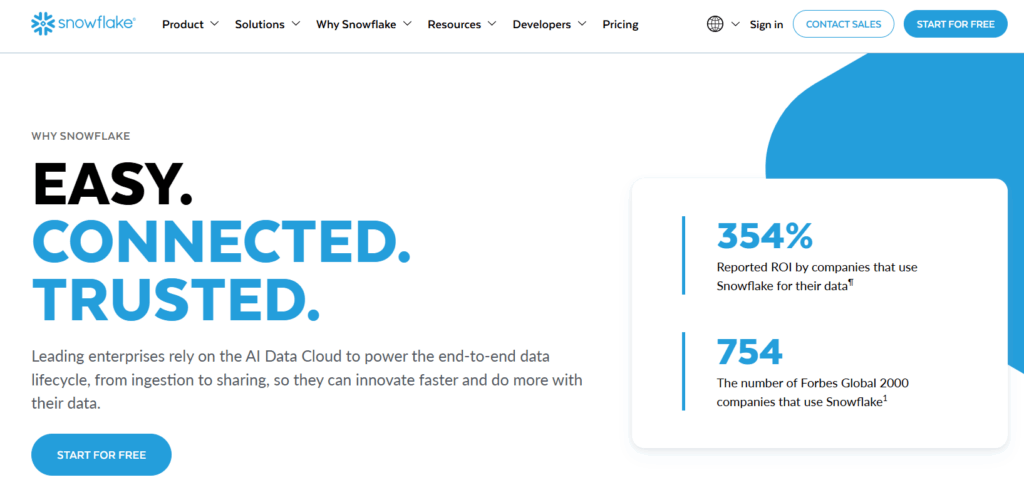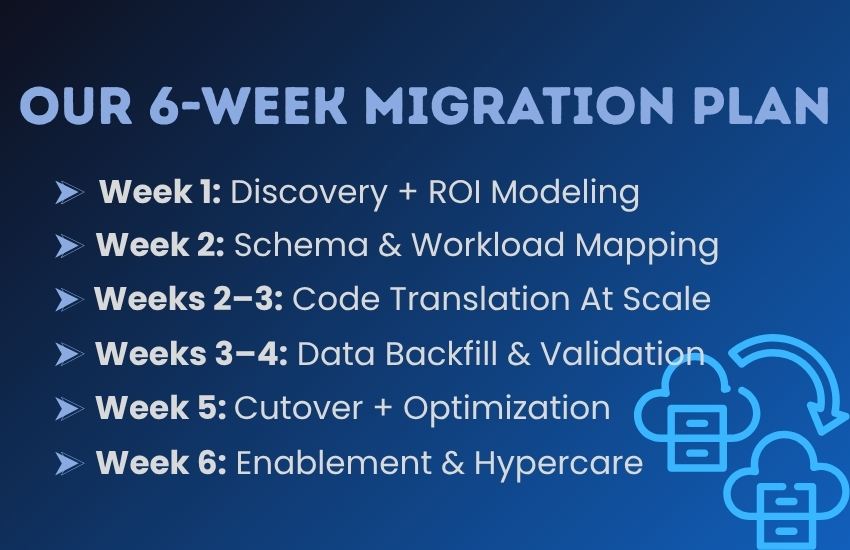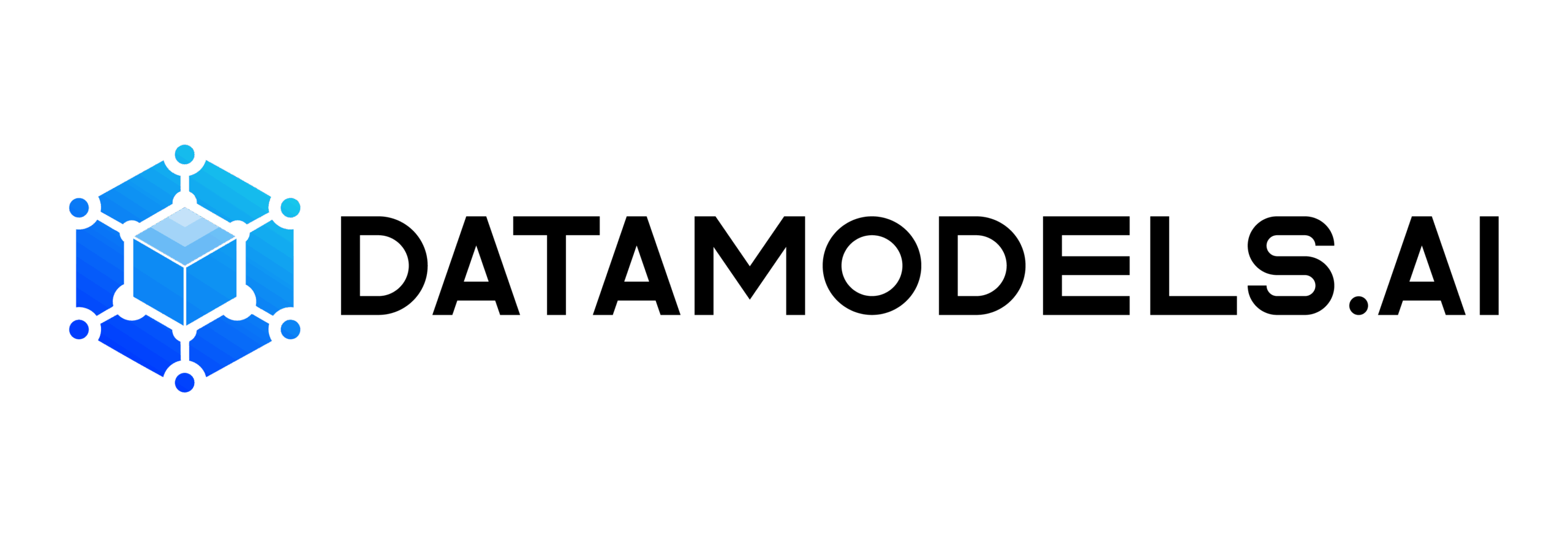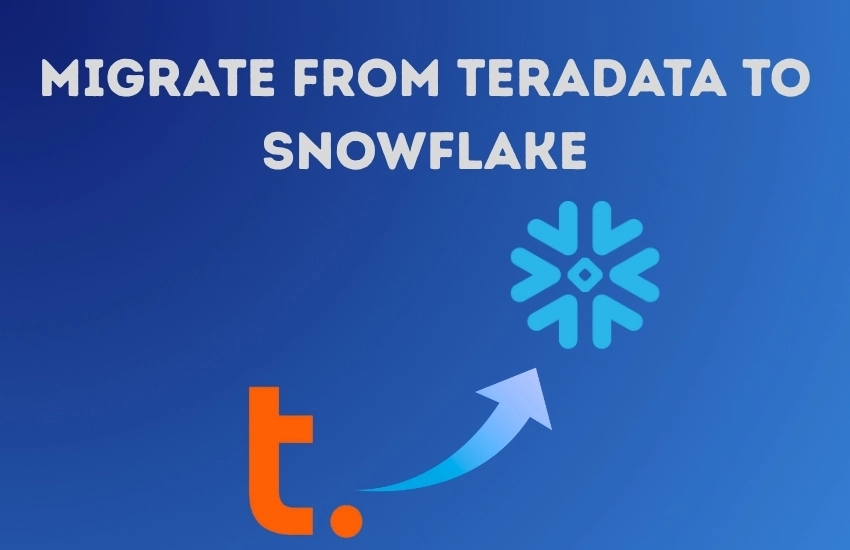Still running Teradata? Then, you’re likely stuck with inflated costs, slow development cycles, and an architecture that’s aging faster than your business can innovate.
Snowflake isn’t just a newer tool—it’s a strategic advantage.
You scale instantly, pay only for what you use, and build with modern tools — from dbt to Snowpark. It’s not just cheaper; it’s designed for speed and agility.
If you want to migrate from Teradata to Snowflake, stay with us till the end!
At DataModels.AI, our 6-week migration accelerator gets you there fast and slashes your costs by 60%. And with no downtime, no guesswork, and no surprises.
Why Is Teradata Holding You Back?
Before we discuss why Snowflake is the right move, let’s consider the drag on your current setup. We’ve worked with clients in industries including finance, healthcare, and SaaS, and the complaints are echo loud and clear.
Sticker Shock & Technical Overhead
Still paying for what you might need — not what you actually use?
Teradata’s traditional pricing model is structured around upfront hardware investments and annual license fees. It often overestimates capacity just to be safe. But when usage dips or peaks unexpectedly, you’re stuck.
- Overprovisioned hardware leads to underutilized spend
- Procurement delays stall access to new compute or storage
- Patch cycles, security updates, and performance tuning devour hours from your ops teams
According to IDC’s Enterprise Infrastructure Tracker, cloud infrastructure spending grew 115% year-over-year in Q3 2024, while non-cloud spending lagged at just 28.6%.
The writing’s on the wall: businesses are ditching legacy tech for flexible, pay-as-you-go models and reaping the financial benefits.
This isn’t about minor technical debt. It’s about a major operational drag that pulls down innovation velocity and eats into margins.
Innovation Bottlenecks
Want to launch a new analytics feature in days? Good luck with Teradata.
In fast-moving organizations, delays aren’t just annoying, they’re expensive. Every week you postpone a product release or delay an insight, you lose ground to faster competitors.
With Teradata:
- Creating dev/test environments means weeks of planning
- Real-time analytics? Practically impossible without custom builds
- Python-native workflows? Only with duct-tape integrations and zero native support
Meanwhile, in the Snowflake ecosystem, innovation velocity is accelerating.
In a report by Snowflake, Python usage surged 571% and over 33,000 LLM applications were developed by 20,000+ users from 2023 to 2024. This is clear a signal that modern teams are prototyping and shipping AI-driven tools at scale.
Innovation starts with infrastructure. If your platform slows down your team’s ability to build, test, and deploy — you’re not just lagging. You’re losing.
Talent and Hiring Challenges
Still hiring Teradata DBAs? That pool’s drying up.
Today’s data engineers want to work with modern stacks — not maintain 20-year-old systems with clunky interfaces and vendor lock-in.
- Teradata specialists command higher salaries due to limited availability
- Younger engineers prefer Snowflake, BigQuery, and cloud-native platforms
- The learning curve for Teradata deters internal cross-skilling
It’s not just a talent problem. It’s a retention problem. You’re overpaying for skillsets that are hard to grow, and you’re stuck depending on a shrinking pool of experts.
Missed Opportunities
Think of every insight delayed, every report delivered late, and every quarter missed.
Here’s the ripple effect of legacy tech:
- Dev cycles drag → dashboards get delivered too late
- Lack of self-service → analysts and execs depend on bottlenecked data teams
- Marketing and product teams wait weeks for campaign or cohort insights
It’s not just inefficiency — it’s lost revenue. In B2B SaaS firms, for instance, late retention reports or lagging LTV metrics directly affect decisions around pricing, product strategy, and customer success.
Let’s stop normalizing delays. There’s a faster, lighter way forward.
Read Also: Data Quality Checklist
What Makes Snowflake A Modern Powerhouse?

By now, you might be thinking: “Okay, Teradata has its limitations… but is Snowflake really that much better?” The short answer? Absolutely.
Snowflake wasn’t just built for the cloud—it was born in it. That distinction matters more than ever.
Unlike Teradata, which locks you in rigid provisioning cycles and siloed environments, Snowflake offers a cloud-native platform for scalability, flexibility, and control.
So, what does Snowflake bring to the table that legacy systems simply can’t match?
Pay-Per-Use Cloud Architecture
Are you tired of overpaying for computing you barely use?
With Snowflake, you pay only for what you use. There’s no need to forecast usage six months in advance or over-provision resources “just in case.” Compute auto-scales with your workloads — and just as importantly, it auto-suspends when idle.
That translates to:
- No wasted spend during weekends or off-hours
- Elastic scale that supports spikes without crashing
- Predictable billing that keeps finance teams happy
This usage-based model isn’t just efficient — it’s fair. It ensures your infrastructure costs scale with actual business value, not guesswork.
Built-In Agility For Modern Teams
Speed matters. But agility — the ability to pivot, experiment, and deliver — is what gives modern teams a real edge.
Snowflake enables you to spin up dev and staging environments in seconds without going through procurement cycles or waiting on IT. You can build, test, and deploy data products with the tools your engineers already love:
- dbt for the modern transformation
- Fivetran & Airflow for seamless orchestration
- Snowpark for running Python, Java, and Scala natively
In short, Snowflake isn’t just a warehouse. It’s an innovation platform that removes blockers and lets your teams move fast — without cutting corners.
Security & Compliance That Grows
In today’s world, security isn’t optional — it’s foundational.
Snowflake offers built-in security features that meet enterprise needs from day one, no matter your industry or compliance burden. Whether you’re in healthcare, finance, or global tech, Snowflake ensures governance doesn’t slow you down.
Key features include:
- Role-based access control (RBAC) and native encryption
- Row- and column-level security for granular data protection
- Certifications like SOC 2 Type II, HIPAA, and GDPR baked in
With Snowflake, security is proactive and not reactive, which means fewer audits, less overhead, and peace of mind.
Future-Proofed Through Interoperability
Still worried about lock-in or future tech debt?
Snowflake is built to evolve, not to expire. Its cross-cloud architecture works seamlessly across AWS, Azure, and GCP, giving you portability and resilience from day one.
And if you need to share data across teams, geographies, or partners, you can do it live — without ETL, duplication, or delay.
This is a platform that doesn’t just work today. It’s engineered to grow with your business.
- Share data securely across clouds
- Tap into Snowflake Marketplace to unlock value from third-party data
- Stay on the cutting edge with continuous platform updates
| Bottom Line Snowflake is the last data platform you’ll need to migrate to, and not the last one, but the only one that improves with time. |
Real-World Migration Success – 60% Cost Savings In Healthcare

What does a successful migration really look like? Let’s discuss a case study from Hakkoda, an IBM Company.
A large U.S.-based healthcare payer was struggling to migrate more than 2 petabytes of data from Teradata across 12 different databases.
The in-house team had been battling slow progress and soaring costs. Manual processes were draining time, 96 hours per week across just three people, and there were no visible wins to show.
They turned to a migration partner with deep Snowflake expertise. Within weeks, things changed dramatically:
- A prioritization framework was put in place to migrate the largest and most valuable tables first
- A fully functional dashboard was launched mid-migration, allowing real-time query optimization
- Stakeholder confidence soared as ROI became visible within weeks — not months
By the end of the 8-month engagement, over 700 critical queries had been migrated and validated, and Teradata had been fully decommissioned. The results?
- 60% reduction in data management costs
- 85% increase in query performance
- 16x faster testing and iteration cycles
This wasn’t just a tech upgrade but a transformation. Teams got faster insights, IT slashed overhead, and business leaders finally had the confidence to scale their data ambitions.
Proof that migrating from Teradata to Snowflake doesn’t just work — it pays.
Read Also: Cloud Cost Optimization Strategies
Speed + Simplicity – What Snowflake Lets You Build!
Tired of waiting weeks just to test a new dashboard? You’re not alone — and that frustration is exactly what Snowflake was built to eliminate.
Once you migrate from Teradata, the execution speed becomes a core advantage — not a bottleneck.
With Snowflake’s on-demand compute and intuitive interface, spinning up a new dev or QA environment takes minutes, not days. Suddenly, your team’s biggest constraint is creativity, not infrastructure.
And it’s not just about speed — it’s what speed enables:
- Faster time to insight → no more backlog of BI requests
- Agile experimentation → test, learn, iterate without waiting on provisioning
- Cross-functional enablement → teams like marketing, finance, and ops access curated data without engineering hand-holding
- Real-time analytics → ingest and query streaming data for faster decisions
- ML/AI support → build and deploy predictive models using Snowpark for Python
Let’s face it! Teradata’s legacy systems weren’t built for this kind of agility. But with Snowflake, your data becomes a launchpad for real-time innovation across your organization.
Imagine your marketing lead launching a new campaign dashboard the same day it’s requested. Or your product team validating a new feature with fresh user data — before the next sprint ends.
That’s the difference between reacting and leading.
A Proven 6-Week Migration Plan That Works

You don’t need a 12-month roadmap, a task force, or sleepless weekends to escape Teradata.
With the right playbook, migrating from Teradata to Snowflake can be done in just six weeks — safely, incrementally, and without disruption.
We’ve helped teams across industries pull this off using a repeatable, low-risk accelerator that delivers fast wins and long-term value.
Let’s walk through it.
Week 1: Discovery + ROI Modeling
We start by mapping the lay of the land. That means understanding your Teradata workloads, schemas, data volumes, and business dependencies.
Then we build your business case: What’s the projected ROI? Where are the quick wins? What’s the total cost of ownership once you’re in Snowflake?
You walk away with a tactical migration plan and executive-aligned justification.
Week 2: Schema & Workload Mapping
This is where our migration engine kicks in.
We analyze your schemas, stored procedures, and BTEQ scripts and map them to Snowflake equivalents. Redundant objects are flagged, and workloads are grouped by criticality and complexity.
The output? A migration map that balances speed, risk, and impact.
Weeks 2–3: Code Translation At Scale
No, you don’t have to rewrite everything manually.
We use automated translation tools, including SQL and BTEQ converters, plus a dbt-Teradata adapter, to handle 80–90% of your code with automation. The remaining edge cases? Our engineers refactor them using best practices and reusable dbt macros.
All changes are version-controlled with CI/CD pipelines via GitHub Actions for full auditability.
Weeks 3–4: Data Backfill & Validation
Next, we kick off data movement in parallel.
Tables are migrated in order of priority, integrity checks run in real-time, and performance benchmarks are captured against Snowflake equivalents. If a query or table underperforms, we tune and optimize on the spot.
This parallel process keeps your Teradata live — no downtime, no break in service.
Week 5: Cutover + Optimization
After testing and validating your workloads, we schedule a phased cutover, typically over a weekend or planned maintenance window.
Post-cutover, we tune compute clusters, schedule jobs, and monitor system health. Snowflake’s performance data makes this faster than old-school DB tuning.
Week 6: Enablement & Hypercare
Finally, we empower your teams.
This includes live enablement sessions, documentation, Slack-based support, and shadowing your users while running live reports and pipelines in Snowflake. Our job? Make sure you own the system, not us.
By the end of Week 6, you’re not just “migrated.” You’re live, trained, and already building.
Tech stack highlights?
We plug in dbt-Teradata adapters, build CI/CD with GitHub Actions, and orchestrate with Airflow pipelines — all geared for Snowflake-native development.
This isn’t migration by guesswork. It’s predictable. It’s proven. And it gets your team to the cloud—faster and stronger.
Common Pushbacks (And What To Say)
We get it — migration makes people nervous. Change always comes with hesitation, especially when there’s legacy investment, complexity, or fear of disruption involved.
But here’s the truth: most objections are rooted in outdated assumptions or misinformation.
Let’s unpack the most common ones and how we confidently address them:
“What if Snowflake locks us in?”
That’s a fair concern. But Snowflake was built to be cloud-agnostic, not restrictive.
- It runs on AWS, Azure, and GCP — switch anytime
- Data sharing is cross-cloud with no ETL or duplication
- You’re not tied to hardware or single-region decisions
You maintain portability and avoid vendor lock-in by design.
“Our BTEQ scripts are too complex to migrate.”
Yes, Teradata scripting can get dense. But modern tooling has changed the game.
- We use auto-translators to convert 80–90% of code
- Complex logic is flagged early and handled with dbt refactors
- We’ve migrated hundreds of BTEQ-heavy workflows — and improved them
Translation is faster than ever and your logic becomes more maintainable.
“What if something breaks mid-migration?”
That’s where dual-run environments and rollback-ready frameworks come in.
- We validate outputs before cutover
- Legacy and Snowflake run in parallel — nothing goes dark
- Our team stays in hypercare mode post-launch
You’re never left in the dark — and never flying blind.
Pushback is normal, but paralysis isn’t a strategy.
With the right architecture, automation, and expertise, migrating from Teradata to Snowflake will be safe and smart.
Conclusion – It’s Time To Leave Legacy Behind!
Still, hanging onto Teradata? Then, you’re likely overpaying, under-delivering, and slowing down innovation.
Snowflake offers a faster, leaner, future-proof alternative.
From elastic, pay-as-you-go pricing to seamless integration with modern tools, it removes the roadblocks legacy systems create — and turns your data into a growth engine.
We’ve helped teams cut data costs by over 60%, accelerate insights, and unlock use cases that were simply out of reach with Teradata.
This isn’t just an upgrade. It’s a transformation.
The longer you wait, the more it costs.
Let’s Get You Moving – Fast!
Ready to cut your Teradata bill in half and innovate twice as fast?
We help modern data teams migrate to Snowflake in just 6 weeks — with zero surprises, zero downtime, and a roadmap tailored to your exact environment.
Book a free consultation with a DataModels.AI architect and get:
- A personalized cost-savings forecast
- A technical feasibility review
- A blueprint for safe, automated migration — no guesswork
The fastest time to value starts here. Let’s unlock it together.

